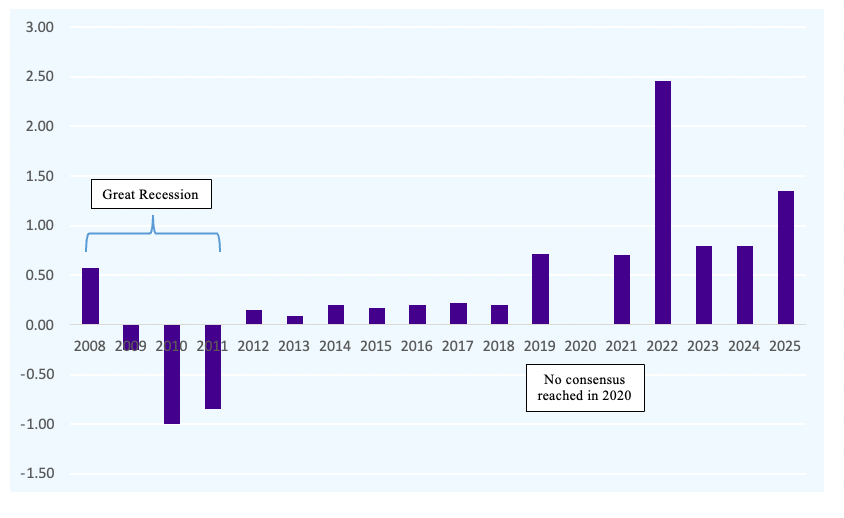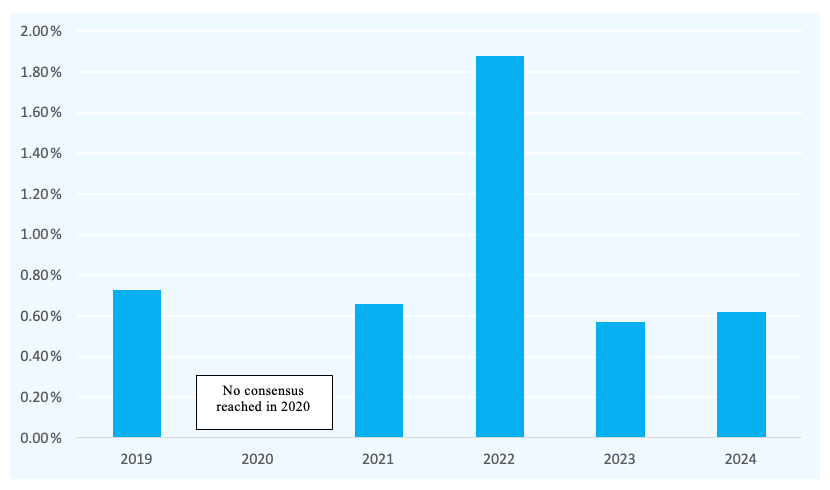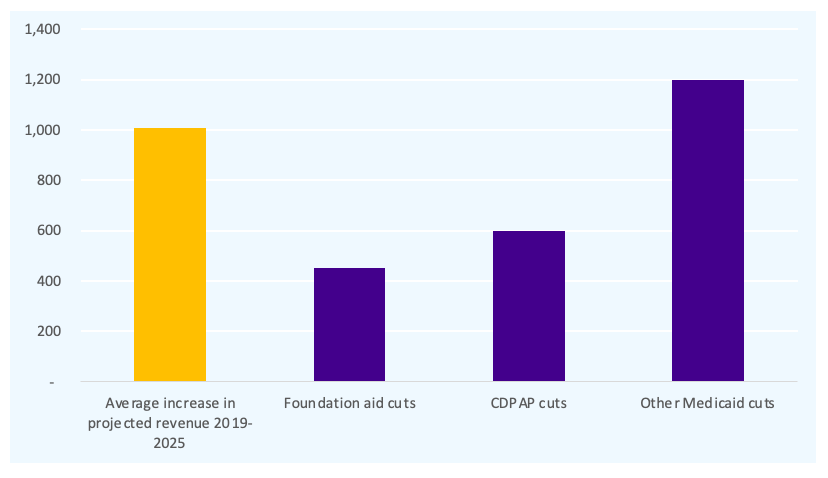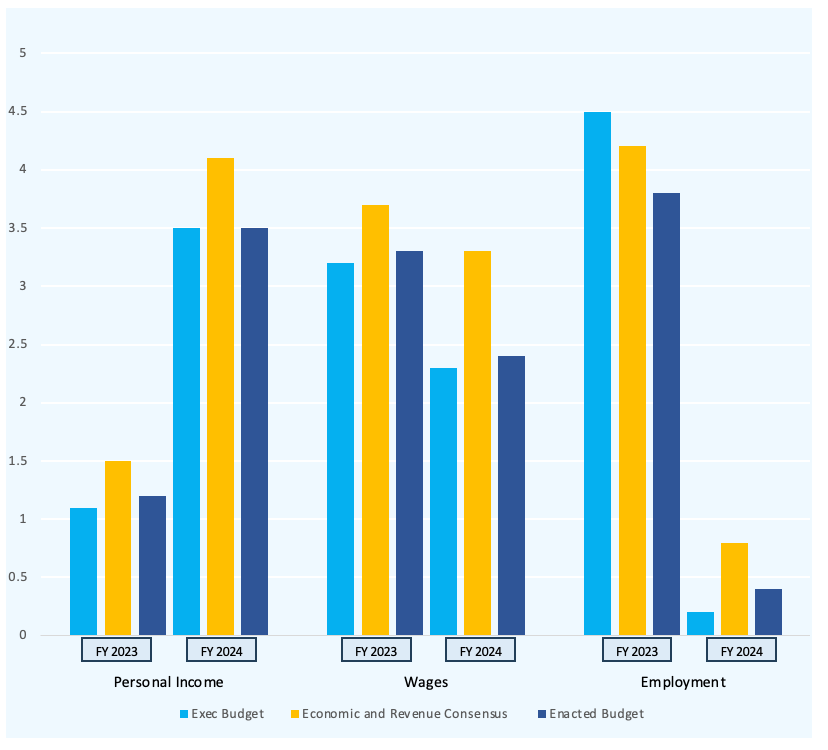Consensus Economic and Revenue Forecast: Finding Quarters in the Couch Cushions
March 4, 2024 |
By Emily Eisner, PhD, Economist
March 4, 2024
Annualized revenue adjustments average $1.01 billion over past seven budget cycles
In the New York State budget process, revenue projections are frequently underestimated. The Division of Budget’s pattern of under-estimation is particularly evident in the State’s Economic and Revenue Consensus Report (henceforth referred to as the “Report”).
The report released Friday, March 1, 2024, adds an additional $1.35 billion in revenue to the total projected revenue for fiscal year 2025 and the remainder of fiscal year 2024. This is higher than the revenue added to projections in recent years. Friday’s revenue upgrade indicates a better fiscal outlook than was predicted by the Division of Budget (DOB) in the executive budget.
What is the Consensus Economic and Revenue Forecast Report?
Article 3 of New York State Finance Law requires that on or before March 1, the Director of the Budget and the chairs and ranking minority members of the Senate Finance Committee and Assembly Ways and Means Committee issue a joint report with their consensus revenue forecasts for the current and upcoming fiscal years. The Consensus Economic Revenue Forecast Report’s intention is for the executive and legislature to agree on a view of the economic and revenue forecasts before the completion of the enacted budget. The report updates the revenue forecasts that were made in the updated executive budget in mid-February.
Before issuing the Consensus Economic and Revenue Forecast Report, the director of the budget, the chairperson and ranking minority member of the Senate Finance Committee, and the chairperson and ranking minority member of Assembly Ways and Means hold a joint meeting at which they establish their consensus view of the economy and revenue situation for New York. To assist in arriving at consensus, each of the parties convening the conference invites an expert who can help inform and validate the economic and revenue projections. The experts could include the state comptroller, but could also include economists of forecasters from outside the state government.
This process of soliciting input from outside experts and convening a bi-partisan meeting including both the legislature and executive only occurs once a year in advance of the enacted budget. None of the other economic and revenue forecast updates through the year includes as much external input, nor do they require consensus be reached across different branches of the state government, making the Consensus Economic and Revenue Forecast Report unique. The only comparable meeting is the “Quick Start” in mid-November when the executive and leaders of the majority and minority in both houses of the legislature meet to discuss the economic and revenue outlook. However, the “Quick Start” meeting does not include analysis from outside experts.
Revenue consensus consistently finds that executive budget under-estimates revenue
While this seemingly thorough and bi-partisan process may inspire confidence in the accuracy of the economic and revenue forecasts that are produced in the revenue consensus, the consensus offers little insight into how data and expert analysis feed into it.
The Report consistently finds projected revenue to be higher than the executive budget initially projects. In five of the past six years, the Report has revised the total revenue forecast for the next two years up by at least $800 million. In 2020, no consensus was reached by the Director of the Budget, the secretary of Senate Finance and the secretary of Ways and Means — thus, no revision to the executive budget revenue forecast was published. Between 2012 and 2018, revisions were always positive and the average revision was $180 million — once again indicating that the executive budget tends to underestimate revenue. The only fiscal years between 2008 and 2024 that saw negative revisions in the Report are the Great Recession years, when the state of the economy was weak.
Figure 1. Increase to revenue forecast for current and subsequent fiscal year.
Billions of US dollars ($)

Over the past five budget cycles, the upward revisions to revenue established at the Economic and Revenue Consensus meeting has ranged from 0.6 percent to 1.9 percent of annual state operating funds. While these numbers may seem small in magnitude, the dollar amounts are significant when compared to current cost saving measures proposed in the fiscal year 2025 executive budget. Annualized revenue adjustments average $972 million over the past 6 budget cycles (excluding 2020) compared to a proposed $454 million in school aid cuts and $600 million in cuts to the homecare program CDPAP in this year’s executive budget.
Figure 2. Percent increase to revenue forecast for current and subsequent fiscal year.
Percentage of actual annual state operating funds revenue

Figure 3. Average revenue improvement compared to FY 2025 executive budget cost saving proposals, annualized
Millions of US Dollars ($)

Consensus economic forecasts do not appear to bear on enacted budget
Finally, the economic forecasts made in the Report over the past two budget cycles appear to have not impacted the enacted budget economic outlook. In both years, the Report upgraded the economic outlook relative to the executive budget in almost all measures. However, despite these upgrades, the enacted budget has continued to reflect a more pessimistic outlook, closer to what was originally put forward by the Division of the Budget.
Figure 4. Economic indicator forecasts for FY 2023 and FY 2024 budget cycles.
Growth rates as percent change (%)

Conclusion
The Consensus Economic and Revenue Forecast report presents an opportunity for the state government to reach a thorough and well-informed projection of both the state economic outlook and revenue. Given that the revenue consensus almost always finds higher revenue than was projected by the executive, it is clear the executive budget consistently under-projects revenue. In addition, updates to economic forecasts do not appear to bear weight on the final enacted budget, suggesting that the Consensus Economic and Revenue Forecast report is not serving its purpose of providing an agreed upon and deeply informed outlook for the executive and legislature to use in their negotiations of the next fiscal year’s budget.
Consensus Economic and Revenue Forecast: Finding Quarters in the Couch Cushions
March 4, 2024 |
By Emily Eisner, PhD, Economist
March 4, 2024
Annualized revenue adjustments average $1.01 billion over past seven budget cycles
In the New York State budget process, revenue projections are frequently underestimated. The Division of Budget’s pattern of under-estimation is particularly evident in the State’s Economic and Revenue Consensus Report (henceforth referred to as the “Report”).
The report released Friday, March 1, 2024, adds an additional $1.35 billion in revenue to the total projected revenue for fiscal year 2025 and the remainder of fiscal year 2024. This is higher than the revenue added to projections in recent years. Friday’s revenue upgrade indicates a better fiscal outlook than was predicted by the Division of Budget (DOB) in the executive budget.
What is the Consensus Economic and Revenue Forecast Report?
Article 3 of New York State Finance Law requires that on or before March 1, the Director of the Budget and the chairs and ranking minority members of the Senate Finance Committee and Assembly Ways and Means Committee issue a joint report with their consensus revenue forecasts for the current and upcoming fiscal years. The Consensus Economic Revenue Forecast Report’s intention is for the executive and legislature to agree on a view of the economic and revenue forecasts before the completion of the enacted budget. The report updates the revenue forecasts that were made in the updated executive budget in mid-February.
Before issuing the Consensus Economic and Revenue Forecast Report, the director of the budget, the chairperson and ranking minority member of the Senate Finance Committee, and the chairperson and ranking minority member of Assembly Ways and Means hold a joint meeting at which they establish their consensus view of the economy and revenue situation for New York. To assist in arriving at consensus, each of the parties convening the conference invites an expert who can help inform and validate the economic and revenue projections. The experts could include the state comptroller, but could also include economists of forecasters from outside the state government.
This process of soliciting input from outside experts and convening a bi-partisan meeting including both the legislature and executive only occurs once a year in advance of the enacted budget. None of the other economic and revenue forecast updates through the year includes as much external input, nor do they require consensus be reached across different branches of the state government, making the Consensus Economic and Revenue Forecast Report unique. The only comparable meeting is the “Quick Start” in mid-November when the executive and leaders of the majority and minority in both houses of the legislature meet to discuss the economic and revenue outlook. However, the “Quick Start” meeting does not include analysis from outside experts.
Revenue consensus consistently finds that executive budget under-estimates revenue
While this seemingly thorough and bi-partisan process may inspire confidence in the accuracy of the economic and revenue forecasts that are produced in the revenue consensus, the consensus offers little insight into how data and expert analysis feed into it.
The Report consistently finds projected revenue to be higher than the executive budget initially projects. In five of the past six years, the Report has revised the total revenue forecast for the next two years up by at least $800 million. In 2020, no consensus was reached by the Director of the Budget, the secretary of Senate Finance and the secretary of Ways and Means — thus, no revision to the executive budget revenue forecast was published. Between 2012 and 2018, revisions were always positive and the average revision was $180 million — once again indicating that the executive budget tends to underestimate revenue. The only fiscal years between 2008 and 2024 that saw negative revisions in the Report are the Great Recession years, when the state of the economy was weak.
Figure 1. Increase to revenue forecast for current and subsequent fiscal year.
Billions of US dollars ($)

Over the past five budget cycles, the upward revisions to revenue established at the Economic and Revenue Consensus meeting has ranged from 0.6 percent to 1.9 percent of annual state operating funds. While these numbers may seem small in magnitude, the dollar amounts are significant when compared to current cost saving measures proposed in the fiscal year 2025 executive budget. Annualized revenue adjustments average $972 million over the past 6 budget cycles (excluding 2020) compared to a proposed $454 million in school aid cuts and $600 million in cuts to the homecare program CDPAP in this year’s executive budget.
Figure 2. Percent increase to revenue forecast for current and subsequent fiscal year.
Percentage of actual annual state operating funds revenue

Figure 3. Average revenue improvement compared to FY 2025 executive budget cost saving proposals, annualized
Millions of US Dollars ($)

Consensus economic forecasts do not appear to bear on enacted budget
Finally, the economic forecasts made in the Report over the past two budget cycles appear to have not impacted the enacted budget economic outlook. In both years, the Report upgraded the economic outlook relative to the executive budget in almost all measures. However, despite these upgrades, the enacted budget has continued to reflect a more pessimistic outlook, closer to what was originally put forward by the Division of the Budget.
Figure 4. Economic indicator forecasts for FY 2023 and FY 2024 budget cycles.
Growth rates as percent change (%)

Conclusion
The Consensus Economic and Revenue Forecast report presents an opportunity for the state government to reach a thorough and well-informed projection of both the state economic outlook and revenue. Given that the revenue consensus almost always finds higher revenue than was projected by the executive, it is clear the executive budget consistently under-projects revenue. In addition, updates to economic forecasts do not appear to bear weight on the final enacted budget, suggesting that the Consensus Economic and Revenue Forecast report is not serving its purpose of providing an agreed upon and deeply informed outlook for the executive and legislature to use in their negotiations of the next fiscal year’s budget.
